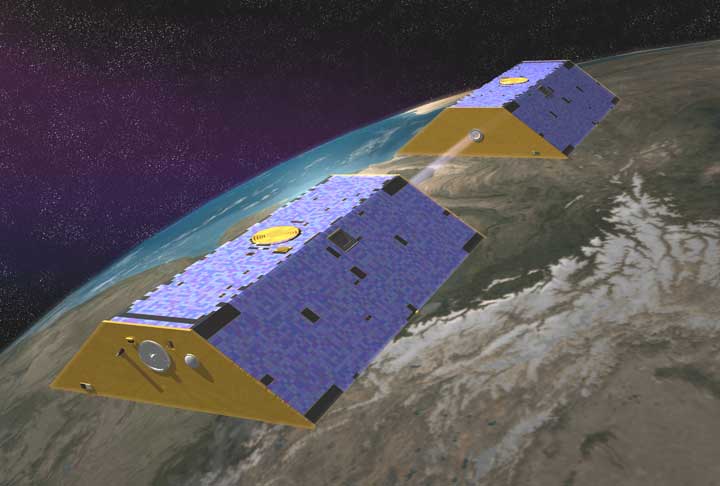A few weeks ago I explained on WUWT that the UT interpretation of GRACE gravity anomaly data was flawed, due to calibration problems caused by isostasy.
A new study from TU Delft, SRON and The Jet Propulsion Laboratory confirms my view.
September 2, 2010 by M & C
The melting of the ice sheets of Greenland and West Antarctica is about twice as slow as previously thought. The study, conducted by TU Delft, SRON and the Jet Propulsion Laboratory. The scientists published their findings in the September issue of Nature Geoscience.
Grace
The melting of ice sheets since 2002 is mapped with measurements of the two GRACE satellites. These detect from space small changes in the gravitational field of the earth. These changes are related to the exact distribution of mass on Earth, including ice and water. As ice melts and sea, is this influence in the gravity field.
Grace
The melting of ice sheets since 2002 is mapped with measurements of the two GRACE satellites. These detect from space small changes in the gravitational field of the earth. These changes are related to the exact distribution of mass on Earth, including ice and water. As ice melts and sea, is this influence in the gravity field.
Giga Tons
Based on this principle were previous estimates for the Greenland ice sheet at 230 gigatons of ice that melts each year (that’s 230,000 billion pounds). This results then in an average global sea level rise of about 0.75 mm per year. For West Antarctica was the estimated 132 gigatons each year.
With these results, it now appears, however, not corrected for glacial Isostatic adjustment, the phenomenon that the earth’s crust continues to soar due to the melting of large ice sheets of the last Ice Age, about 20,000 years ago. These movements of the crust should you take in the calculations for these vertical motions change the mass distribution of the earth and so they also affect the gravity field.
h/t to WUWT reader “seven”



Even at half the speed aren’t they still melting?
[Reply : Yes, as they have been since the end of the last ice age]
Steve
Hope your new blog goes well, it’s a shame you won’t be posting articles at WUWT but hope you will keep on commenting there.
I work with sea levels, and as it says in Chapter 5 of AR4 there are large inaccuracies to the satellite measuring system, to the extent that tide gauges are still preferred over that method.
Similarly the methods of measuring arctic ice and global temperatures are highly complex and from my reading of both appear to be suspect.
We believe far too much in the absolute accuracy of the satelllites and it would therefore be interesting to see an objective post deconstructing the data from all the satellites to see if we should be putting so much faith in what they are telling us.
If you can find the time to wander over to;
http://diggingintheclay.wordpress.com/2010/09/01/in-search-of-cooling-trends/#more-630
OR
http://noconsensus.wordpress.com/2010/09/02/in-search-of-cooling-trends/
we would be glad to have your perspective on new study by myself and Verity Jones which shows substantial areas of the globe have been cooling for a statistically meaningful numnber of years (30 plus) and the interesting sine wave like pattern the data exhibits.
All the best
tonyb
Pingback: A Simple Proof That Ice Sheet Melt Has Not Accelerated | Real Science